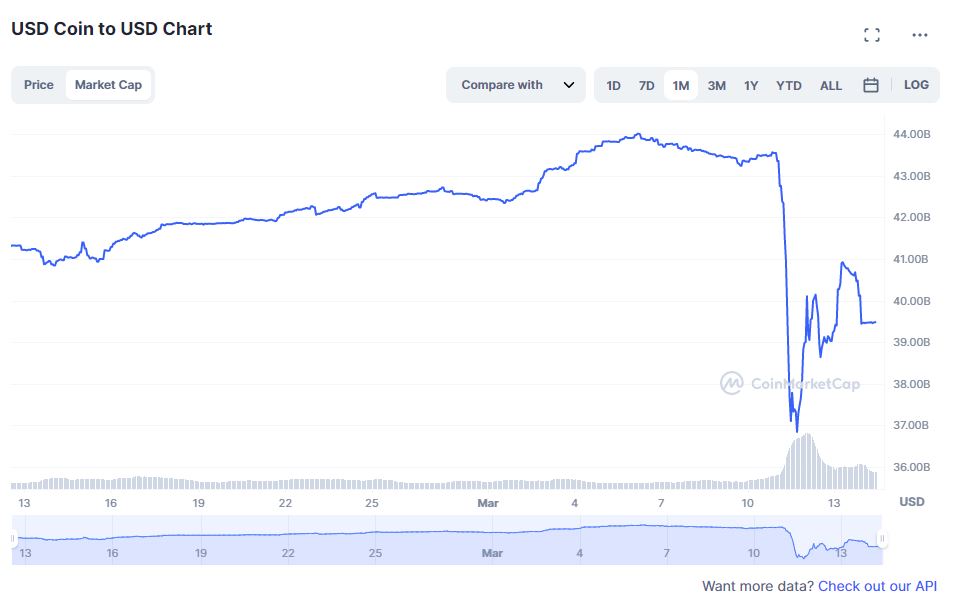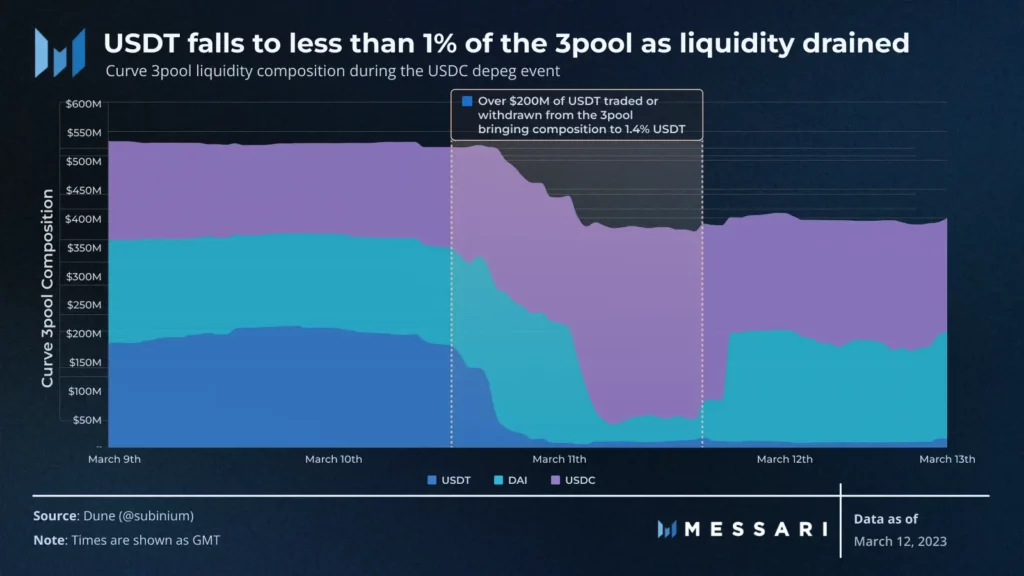Key Takeaways:
- Despite USDC restoring its peg, the crash damaged the DeFi sector.
- Traders flooded CEXs and DEXs with USDC, in efforts to get rid of the coin.
- The DeFi sector is far too dependent on the stabelcoin, and could suffer more damage in the wake of the incident.

YEREVAN (CoinChapter.com) – Starting March 8, a chain of US bank runs shook the market.
One was Silicon Valley Bank (SVB), taken over by regulators on March 10. The contagion then spread into the stablecoin sector, as Circle, the issuer of the second-largest stablecoin by market cap, USDC, admitted to holding $3.3 billion of cash at the bank.
The SVB crash impacted its ability to meet redemption, inciting fear in USDC holders. As a result, the $1 peg broke, falling to a low of $0.87. USDC restored the parity after the US regulators’ effort to keep SVB clients afloat. However, the incident came close to crashing the DeFi market. Here’s why.
USDC market cap is still below $40B
Despite the fact that USDC reestablished its dollar peg, the stablecoin’s market cap did not fully recover. As seen on the chart below, the metric steadily rose before the crash, partially due to rival Binance stablecoin’s troubles with regulators. As a result, the USDC market cap reached $44 billion on March 9.
However, the depeg incident caused a mass exodus, wiping over 4 billion off the stablecoin’s market cap, and the latter stood at $39.4 billion on March 14.

So, how did the USDC supply redistribute across the market?
USDC supply spreads across the DeFi sector
Ethereum is the primary ecosystem for USDC. The blockchain secures the vast majority of USDC, accounting for roughly 95% of the supply, according to the analytical platform Messari. Moreover, the noted decline in market cap was mostly due to sales by Ethereum’s externally owned addresses (EOAs), as their balances dropped to a 12-month low.
The supply released from EOA holders has predominantly been absorbed by centralized exchanges (CEXs) as the exchange balance had increased by nearly 50% in two weeks, per data on March 12. Incidentally, the noted increase of USDC balance on CEXs accounted for approximately half of the supply dumped on the market from EOAs.
The other half has been spread out across DeFi, namely in DEX pools and lending markets where holders sought tokens without market or depeg risks. For example, Maker’s PSM saw nearly $2 billion of USDC inflows, and Curve’s 3pool saw $1.6 billion of inflows.
read the Messari report.
Also read: Apollo Global among potential buyers of Silicon Valley Bank shares as contagion spreads.
Meanwhile, USDC supply flowing out of EOA wallets into DeFi protocols proved to be an unpredictable liquidity environment.
Stablecoin liquidity under risk
USDC is an essential part of the DeFi market. It is the most liquid stablecoin on money markets like Aave and Compound and makes the majority of the collateral backing DAI. Therefore, USDC maintaining its peg and available liquidity is crucial to DeFi operations.
However, once USDC lost its peg, liquidity pools (LPs), and traders scrambled to get rid of the coin, as the outflows mentioned above testify. Furthermore, the leading stablecoin Tether (USDT) saw a corresponding exodus.
The LP 3pool was nearly drained of USDT as the share of Tether stablecoin fell from over a third to nearly 1% of the pool liquidity.

Similar results occurred for Uniswap. The exchange’s USDC<>USDT pool was also drained of USDT as investors traded/withdrew 99% or $31 million of Tether stablecoins. Moreover, Uniswap traders broke the record, reaching a trading volume of nearly $12 billion on March 11.
The USDC depeg and the subsequent liquidity issues prove that the DeFi sector is over-reliant on the stablecoin.
However, the issue lies not with USDC, but rather with the rigid, mechanistic assumptions taken within DeFi protocols. Protocols hardcoding the price of USDC or blanket assuming it will always equal $1, make an assumption that, as events have proven, doesn’t always hold true.
concluded Messari.
Also read: GCR says bye to Binance, withdraws $40M USDT – should traders follow?
Click here to keep up with the ever-changing crypto market and never miss the scoop!


